Optical Imaging Market Size
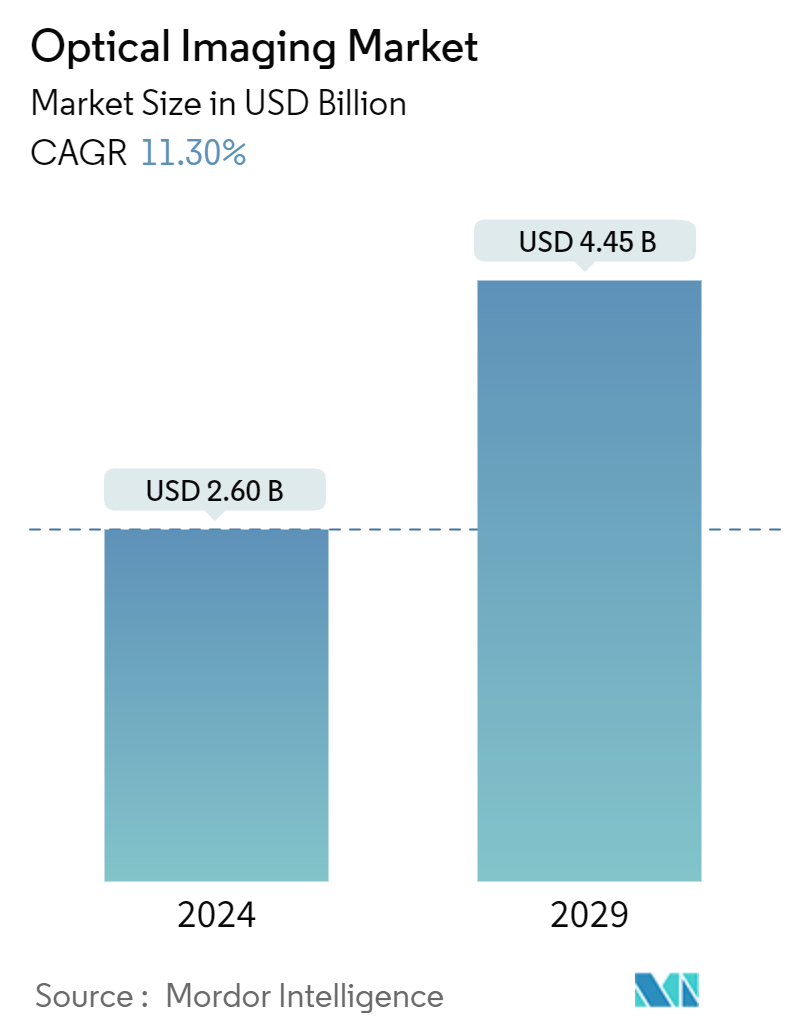
| Study Period | 2019 - 2029 |
| Market Size (2024) | USD 2.60 Billion |
| Market Size (2029) | USD 4.45 Billion |
| CAGR (2024 - 2029) | 11.30 % |
| Fastest Growing Market | Asia Pacific |
| Largest Market | Asia Pacific |
Major Players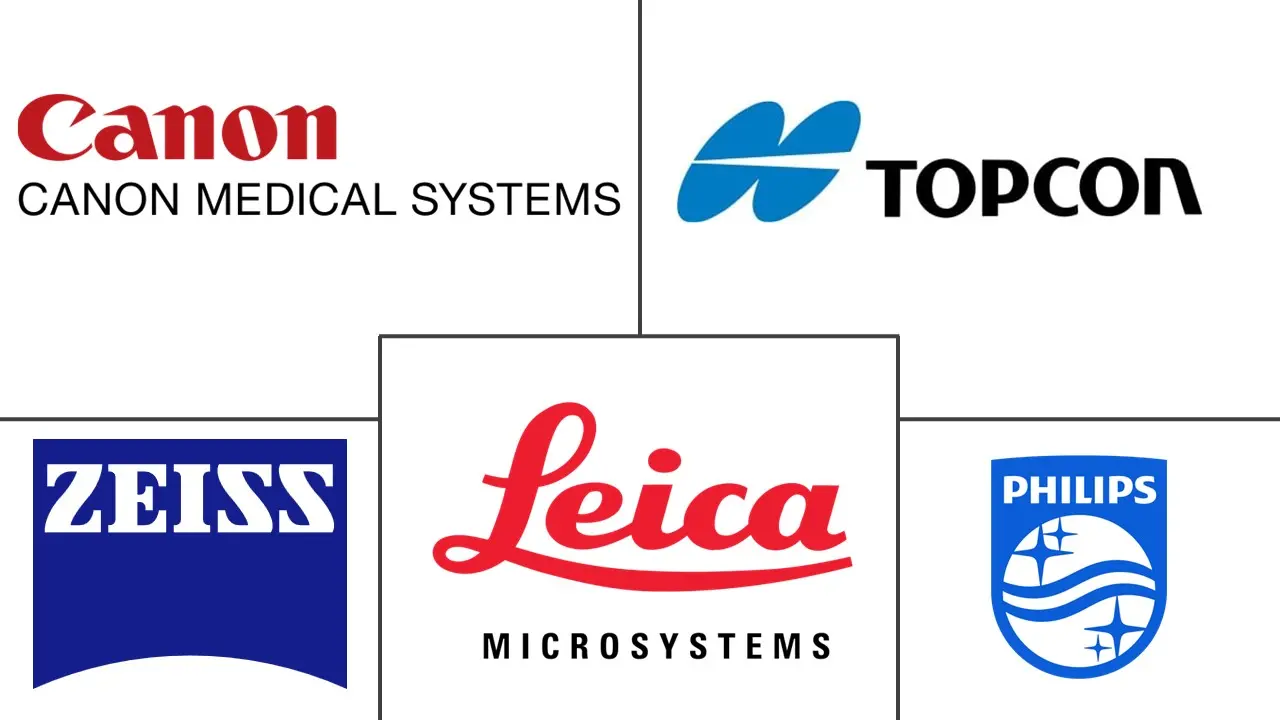
*Disclaimer: Major Players sorted in no particular order |
Need a report that reflects how COVID-19 has impacted this market and its growth?
Optical Imaging Market Analysis
The Optical Imaging Market size is estimated at USD 2.60 billion in 2024, and is expected to reach USD 4.45 billion by 2029, growing at a CAGR of 11.30% during the forecast period (2024-2029).
Optical imaging is an emerging technology with great possibility for enhancing disease prevention, treatment, and diagnosis in the medical office or in the operating room. Optical imaging delivers the chance to differentiate between soft and affected tissues. This ability of optical imaging to distinguish between healthy and infectious tissues is creating a massive opportunity in the medical diagnosis industry.
• Optical imaging systems are used in the diagnosis of disease, preclinical research, and scanning of multiple cellular and molecular in vivo processes such as protein degradation, protein integration, and protease activity. The market has gained prominence in biotechnological and pharmaceutical companies. Additionally, optical imaging technology offers great flexibility owing to its multispectral potential and high resolution, which helps diagnose and treat atherosclerosis and related diseases.
• Medical imaging technologies continue to advance, presenting new applications in diagnosing and treating diseases. Rapid developments in optical imaging technology and instruments have led to significant breakthroughs in understanding fundamental biological phenomena and rapid diagnosis of diseases, such as optical coherence tomography, photo-acoustic imaging, stimulated resonance raman imaging, multiphoton microscopy, and super-resolution microscopy. Some technologies have been translated into biomedical applications, and some are on the doorstep. Collaborative efforts from both optical and biomedical communities are still needed to fully discover the potential of these optical modalities and promote them as routine laboratory and/or clinical apparatus.
• Optical imaging techniques, such as optical coherence tomography, offer high spatial resolution and contrast, allowing medical practitioners to visualize tissue structures, cellular morphology, and molecular interactions with exceptional detail. Enhanced imaging capabilities enable the detection of subtle abnormalities and early-stage pathology that may not be apparent with conventional imaging methods.
• Optical imaging products have high initial costs primarily because of several factors, including the complexity of the technology, precision manufacturing processes, quality materials, and, often, limited market demand. Further, the research and development phase requires significant investment in exploring and refining advanced photonics technologies.
• More people are seeking medical care that was delayed or postponed due to the COVID-19 pandemic. It may take several years for many healthcare systems to address huge patient backlogs, which is expected to increase the demand for new medical equipment and, consequently, more chips. In addition, the global growth in chip demand is expected to accelerate significantly in the coming years, causing severe chip shortages for numerous industries.
Optical Imaging Market Trends
Oncology Application Segment is Expected to Hold Significant Market Share
- In oncology, optical imaging technology is crucial in cancer diagnosis, treatment, and research. Optical imaging techniques, such as fluorescence imaging and optical coherence tomography (OCT), can assist in the early detection of cancerous lesions. These methods provide high-resolution images, helping clinicians identify abnormal tissue changes that may indicate the presence of cancer.
- In addition, optical imaging is utilized during surgical procedures to guide surgeons in real time. Intraoperative imaging techniques, like fluorescence-guided surgery, help surgeons visualize tumor boundaries and ensure more precise removal of cancerous tissue while minimizing damage to surrounding healthy tissue. Also, it can be used to monitor the response of tumors to treatment, such as chemotherapy or radiation therapy. Changes in tissue optical properties can indicate the effectiveness of the treatment, allowing for timely adjustments to the therapeutic approach.
- The oncology segment registered a significant revenue share in the optical imaging market. Primarily due to the optical way of examining tissues, it can detect both the structural and biochemical aspects of the tissue. It also has the benefits of increased sensitivity, low cost, and high resolution. The technique is also gaining popularity since it assists in the early identification of cancer and is non-invasive. As cancer is becoming prevalent, along with the benefits optical imaging delivers in early cancer detection, the segment’s growth is expected to surge.
- Furthermore, the growing burden of cancer globally further raises the need for advanced cancer treatments to treat different types of cancers, which is anticipated to drive market growth. For instance, in January 2024, according to the American Cancer Society, over 18 million Americans were reported to have cancer in the year 2022. It is estimated that over 2 million new cancer cases are predicted to be diagnosed in the United States in 2024.
- According to the WHO and the International Agency for Research on Cancer, globally, there are around 19.2 million new cases of cancer. This number is predicted to increase to around 30.2 million incident cases in the year 2040. Thus, the high burden of cancer worldwide is expected to propel market evolution in the coming years.
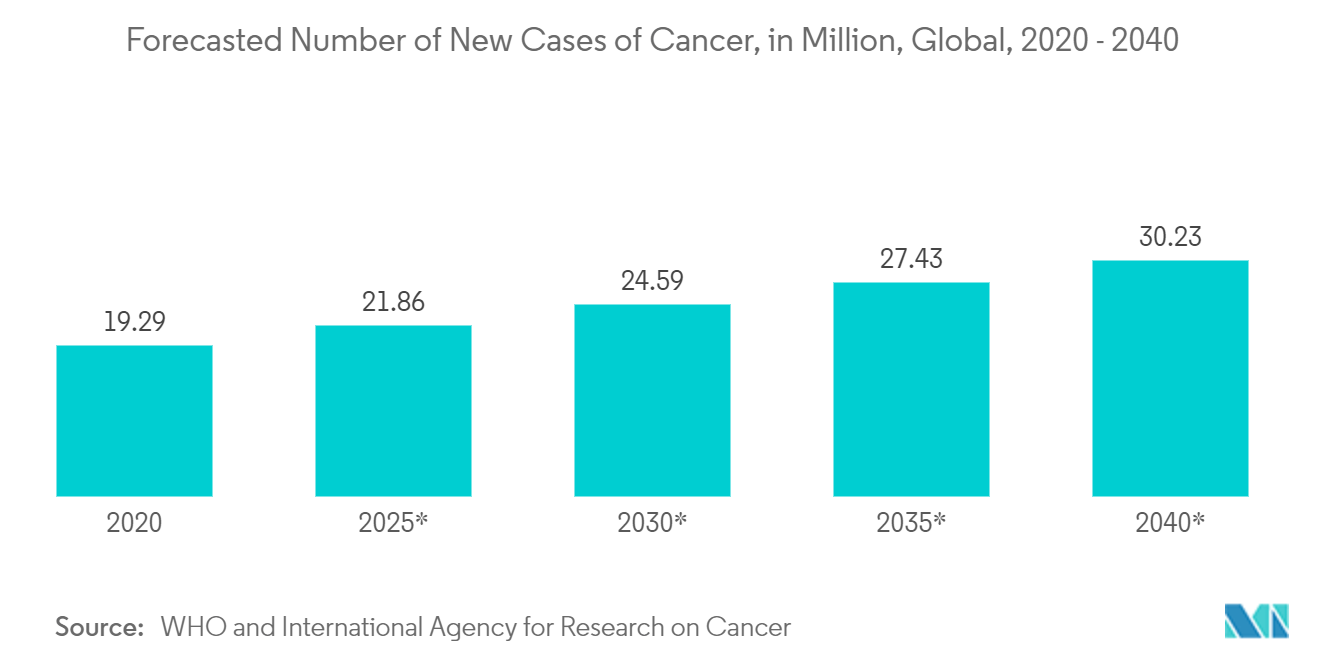
Asia-Pacific to Hold Major Market Share
- The optical imaging market in China is experiencing rapid growth, driven by technological advancements, increasing healthcare expenditure, and a growing aging population. According to the National Bureau of Statistics of China, in 2023, approximately 68.3% of the population worked between 15 and 64 years of age. Retirees aged 65 and above comprised about 15.4% of the total population. The demand for optical imaging devices, like optical coherence tomography and endoscopy systems, is rising due to their effectiveness in diagnosing various medical conditions.
- Optical imaging techniques have sown promise in the study and diagnosis of dementia, particularly Alzheimer's disease. These techniques offer non-invasive and potentially more accessible methods for early detection and monitoring of neurodegenerative diseases. Labe-free optical imaging techniques, like spectroscopic imaging and optical coherence tomography, have emerged as promising tools for diagnosing and studying neurodegenerative disorders.
- Optical imagining techniques, including near-infrared spectroscopy and OCT, provide non-invasive and portable neuroimaging methods for quantifying changes in the brain's oxygenated and deoxygenated hemoglobin concentrations. These techniques offer an attractive alternative to traditional imaging methods, such as position emission tomography and functional magnetic resonance imaging, due to their non-invasiveness, portability, and potential for a larger variety of experiments.
- One of the primary factors fueling the demand for optical imaging in India is the country's rapidly advancing healthcare infrastructure. As India continues to invest in modernizing its medical facilities, there is a growing emphasis on incorporating advanced diagnostic and imaging technologies.
- Optical imaging, with its ability to detect early signs of diseases and guide minimally invasive procedures, is becoming indispensable in diagnosing and managing various medical conditions.
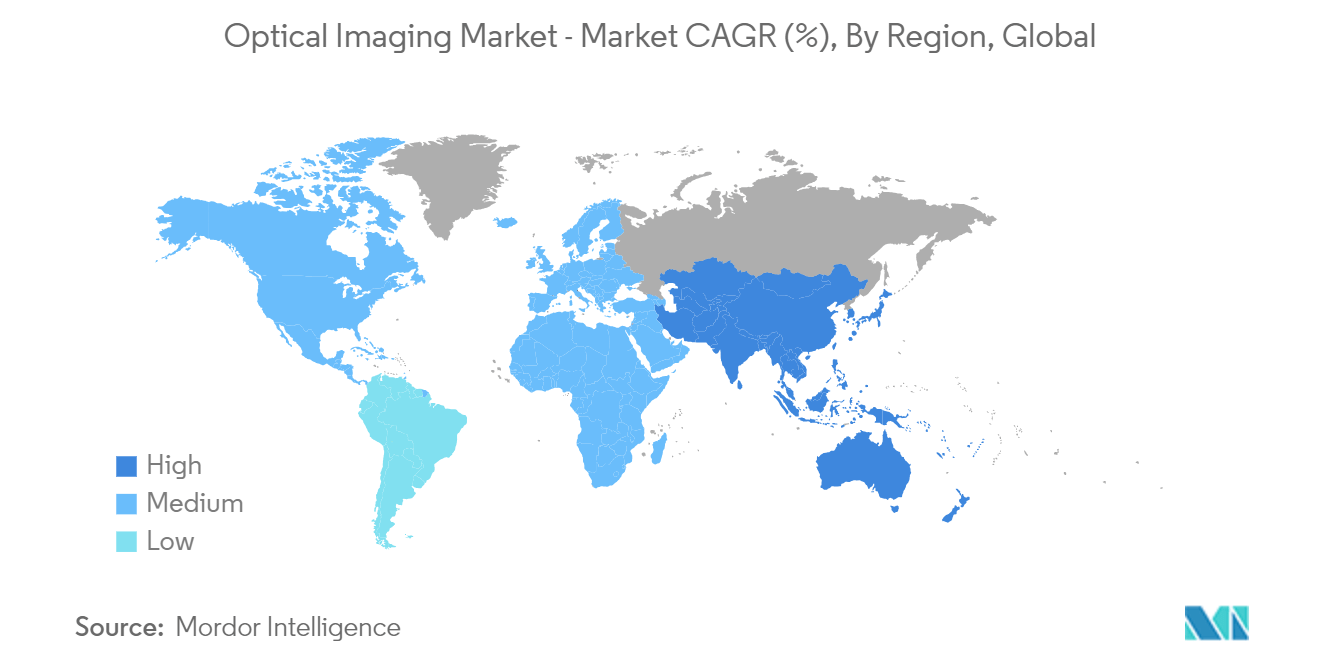
Optical Imaging Industry Overview
The optical imaging market is highly fragmented, with the presence of major players like Carl Zeiss AG, Leica Microsystems (Danaher Corporation), Topcon Corporation, Canon Medical Systems Corporation (Canon Inc.), and Koninklijke Philips NV (Philips). Players in the market are adopting strategies such as partnerships and acquisitions to enhance their product offerings and gain sustainable competitive advantage.
- October 2023 - Leica Microsystems ("Leica") announced the official opening of its USD 60 million medical manufacturing and R&D facility in Singapore. As one of Leica's four global production sites, Singapore is solely responsible for manufacturing surgical microscopes for export to global markets.
- August 2023 - Abbott announced its ILUMIEN IV OPTIMAL PCI (ILUMIEN IV) clinical study, which demonstrated that intravascular imaging through optical coherence tomography (OCT) can enhance stent procedural outcomes, especially in complex cases. The study demonstrated that OCT guidance resulted in a statistically significant 7% rise in MSA compared to angiography guidance alone.
Optical Imaging Market Leaders
Carl Zeiss AG
Leica Microsystems (Danaher Corporation)
Topcon Corporation
Canon Medical Systems Corporation (Canon Inc.)
Koninklijke Philips NV (Philips)
*Disclaimer: Major Players sorted in no particular order
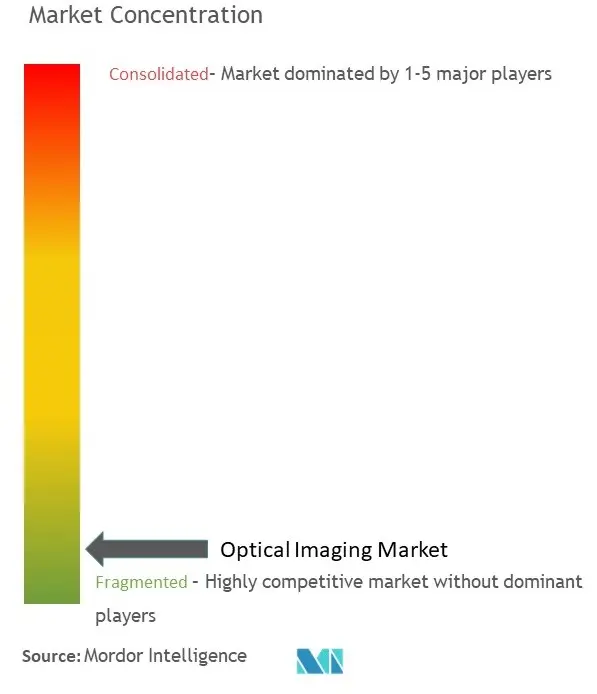
Optical Imaging Market News
- September 2023 - Revvity released many advanced preclinical imaging technologies across multiple applications in preclinical research. These new innovations consist of the IVIS SpectrumCT 2 and next-generation IVIS Spectrum 2 imaging systems. This increases the sensitivity standards and versatility of in vivo optical imaging.
- October 2023 - Abbott launched Ultreon 1.0, a coronary imaging software in India. This software merges optical coherence tomography (OCT) with artificial intelligence (AI), providing physicians with a view of blood flow and blockages within coronary arteries. The software can differentiate between calcified and non-calcified blockages, detect the severity of calcium-based blockages, and measure vessel diameter. It also aids physicians in guiding stent deployment and ensuring optimal stent expansion.
Optical Imaging Market Report - Table of Contents
1. INTRODUCTION
1.1 Study Assumptions and Market Definition
1.2 Scope of the Study
2. RESEARCH METHODOLOGY
3. EXECUTIVE SUMMARY
4. MARKET INSIGHTS
4.1 Market Overview
4.2 Industry Attractiveness - Porter's Five Forces Analysis
4.2.1 Bargaining Power of Suppliers
4.2.2 Bargaining Power of Buyers
4.2.3 Threat of New Entrants
4.2.4 Threat of Substitutes
4.2.5 Intensity of Competitive Rivalry
4.3 Impact of COVID-19 After-effects and Other Macroeconomic Factors on the Market
5. MARKET DYNAMICS
5.1 Market Drivers
5.1.1 Technological Advancements
5.1.2 Ability to Give Enhanced Pictures to Medical Practitioners, for Diagnosing Complex Diseases
5.2 Market Challenges
5.2.1 High-Cost Factor Associated With the Products
6. MARKET SEGMENTATION
6.1 By Product
6.1.1 Imaging Systems
6.1.1.1 Optical Imaging Systems
6.1.1.2 Spectral Imaging Systems
6.1.2 By Illumination System
6.1.3 Lenses
6.1.4 Software
6.2 By Application
6.2.1 Ophthalmology
6.2.2 Dentistry
6.2.3 Dermatology
6.2.4 Cardiology
6.2.5 Neurology
6.2.6 Oncology
6.2.7 Biotechnology and Research
6.2.8 Other Applications
6.3 By Technique
6.3.1 Optical Coherence Tomography
6.3.2 Near Infrared Spectroscopy
6.3.3 Hyperspectral Imaging
6.3.4 Photoacoustic Tomography
6.4 By End User
6.4.1 Diagnostic Imaging Center
6.4.2 Hospitals and Clinics
6.4.3 Research Laboratories
6.4.4 Other End Users
6.5 By Geography***
6.5.1 North America
6.5.1.1 United States
6.5.1.2 Canada
6.5.2 Europe
6.5.2.1 Germany
6.5.2.2 United Kingdom
6.5.2.3 France
6.5.3 Asia-Pacific
6.5.3.1 China
6.5.3.2 Japan
6.5.3.3 India
6.5.3.4 Australia and New Zealand
6.5.4 Latin America
6.5.5 Middle East and Africa
7. COMPETITIVE LANDSCAPE
7.1 Company Profiles*
7.1.1 Carl Zeiss AG
7.1.2 Leica Microsystems (Danaher Corporation)
7.1.3 Topcon Corporation
7.1.4 Canon Medical Systems Corporation (Canon Inc.)
7.1.5 Koninklijke Philips NV (Philips)
7.1.6 Perkinelmer Inc.
7.1.7 Nikon Metrology NV (Nikon Corporation)
7.1.8 Olympus Corporation
7.1.9 Teledyne Princeton Instruments (Teledyne Technologies)
7.1.10 Prior Scientific
7.1.11 Thorlabs Inc.
7.1.12 Abbott Laboratories
7.1.13 Headwall Photonics Inc.
8. INVESTMENT ANALYSIS
9. MARKET OPPORTUNITIES AND FUTURE TRENDS
Optical Imaging Industry Segmentation
Optical imaging examines cellular and molecular activity in live tissue, including that of animals and plants. The information is ultimately taken from the biomolecular functions and tissue makeup. Photons of light with wavelengths ranging from ultraviolet to near-infrared are used to create images.
The optical imaging market is segmented by product (imaging systems [optical imaging systems, spectral imaging systems], illumination systems, lenses, and software), application (ophthalmology, dentistry, dermatology, cardiology, neurology, oncology, biotechnology and research, and other applications), technique (optical coherence tomography, near-infrared spectroscopy, hyperspectral imaging, photo-acoustic tomography), end user (diagnostic imaging center, hospitals and clinics, research laboratories, and other end users), geography (North America [United States, Canada], Europe [Germany, United Kingdom, France, Rest of Europe], Asia-Pacific [China, Japan, India, Rest of Asia-Pacific], Latin America, and Middle East and Africa). The report offers market forecasts and size in value (USD) for all the above segments.
| By Product | ||||
| ||||
| By Illumination System | ||||
| Lenses | ||||
| Software |
| By Application | |
| Ophthalmology | |
| Dentistry | |
| Dermatology | |
| Cardiology | |
| Neurology | |
| Oncology | |
| Biotechnology and Research | |
| Other Applications |
| By Technique | |
| Optical Coherence Tomography | |
| Near Infrared Spectroscopy | |
| Hyperspectral Imaging | |
| Photoacoustic Tomography |
| By End User | |
| Diagnostic Imaging Center | |
| Hospitals and Clinics | |
| Research Laboratories | |
| Other End Users |
| By Geography*** | ||||||
| ||||||
| ||||||
| ||||||
| Latin America | ||||||
| Middle East and Africa |
Optical Imaging Market Research FAQs
How big is the Optical Imaging Market?
The Optical Imaging Market size is expected to reach USD 2.60 billion in 2024 and grow at a CAGR of 11.30% to reach USD 4.45 billion by 2029.
What is the current Optical Imaging Market size?
In 2024, the Optical Imaging Market size is expected to reach USD 2.60 billion.
Who are the key players in Optical Imaging Market?
Carl Zeiss AG, Leica Microsystems (Danaher Corporation), Topcon Corporation, Canon Medical Systems Corporation (Canon Inc.) and Koninklijke Philips NV (Philips) are the major companies operating in the Optical Imaging Market.
Which is the fastest growing region in Optical Imaging Market?
Asia Pacific is estimated to grow at the highest CAGR over the forecast period (2024-2029).
Which region has the biggest share in Optical Imaging Market?
In 2024, the Asia Pacific accounts for the largest market share in Optical Imaging Market.
What years does this Optical Imaging Market cover, and what was the market size in 2023?
In 2023, the Optical Imaging Market size was estimated at USD 2.31 billion. The report covers the Optical Imaging Market historical market size for years: 2019, 2020, 2021, 2022 and 2023. The report also forecasts the Optical Imaging Market size for years: 2024, 2025, 2026, 2027, 2028 and 2029.
Optical Imaging System Industry Report
Statistics for the 2024 Optical Imaging System market share, size and revenue growth rate, created by Mordor Intelligence™ Industry Reports. Optical Imaging System analysis includes a market forecast outlook to 2029 and historical overview. Get a sample of this industry analysis as a free report PDF download.
